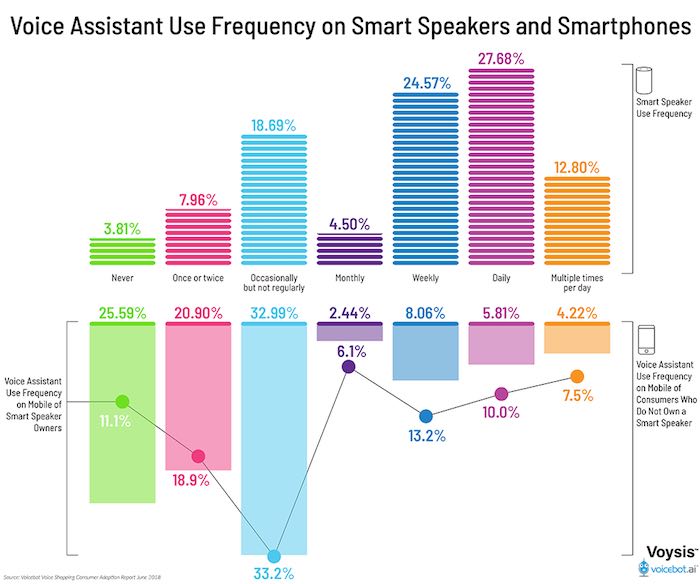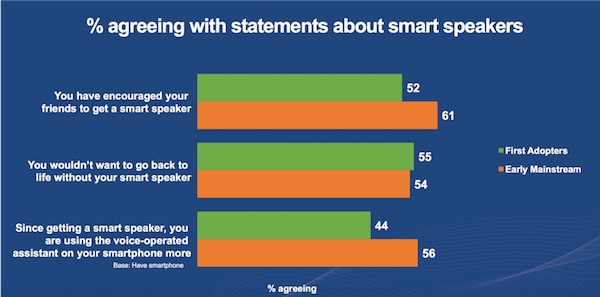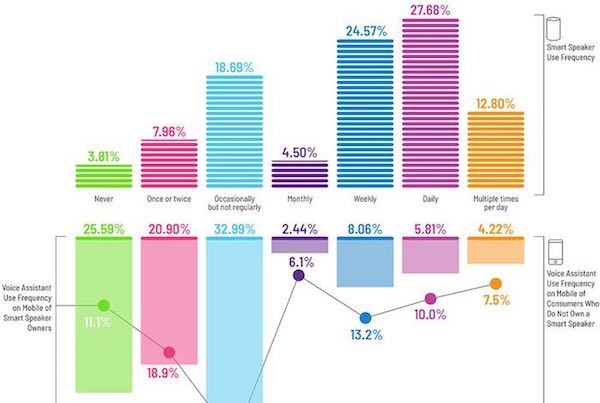Smart Speakers are the Gateway to Increased Voice Assistant Use on Mobile
Siri’s 2011 introduction on the iPhone was the first encounter many consumers had with a voice assistant. Voice assistant availability expanded to other smartphone platforms but despite widespread trial, they didn’t become adopted broadly or with high frequency. Instead of adopting speak and listen for smartphone interaction, consumers retreated to habits around touch, swipe and view. Smart speakers entered the market and everything was different. You can only interact with the devices by voice so there is nowhere to retreat. And, the voice assistants onboard such as Alexa and Google Assistant, have not only become broadly available, they are also frequently used.
In a May survey of 1200 U.S. adults, Voicebot and Voysis found that about 70% of smart speaker owners used them at least monthly and 40% daily. By contrast, only about 20% reported monthly use of a voice assistant on smartphones and daily use was just 10%. Beneath the surface data, however, was another interesting finding. Smart speaker owners use voice assistants on smartphones at a much higher rate than the average. Only about 21% of consumers that do not own smart speakers are monthly users of voice assistants on smartphones. For smart speaker owners, that number jumps up to 37%.

Smart Speakers are Voice Assistant Training Devices
It turns out that this correlation between higher voice assistant use on smartphones and smart speaker ownership is not coincidental. Smart speakers are turning out to be voice assistant awareness and training devices. A study from Edison Research and NPR found that 44% of consumers that have owned a smart speaker for more than a year and 56% that have purchased one more recently say they are using their smartphone-based voice assistant more frequently since the device purchase.

What happens is that a consumer starts using voice on their smart speaker and the activity makes voice interaction a top of mind option. Then, when they are not near a smart speaker, the consumer thinks about asking a question by voice, but realizes two things almost simultaneously: they are not near a smart speaker, but their smartphone has a voice assistant. Not all mobile use cases lend themselves well to voice, but when they do it is top of mind and more likely to be used.
Voice assistant access on smartphones is about 20 times higher globally today than through smart speakers. This means the near-term future of voice assistants will be heavily influenced by smartphones simply due to greater consumer reach. It appears the smartphone users that will be in the vanguard of a shift to voice interaction, will be the early adopters of smart speakers. This little recognized impact may well shape the industry over the next two years and provide a big advantage for voice assistant platforms that also have popular smart speakers.
New Smart Speaker Owners Using Them More for Pre-Purchase Product Research
Smart Speakers to Reach 100 Million Installed Base Worldwide in 2018, Google to Catch Amazon by 2022









